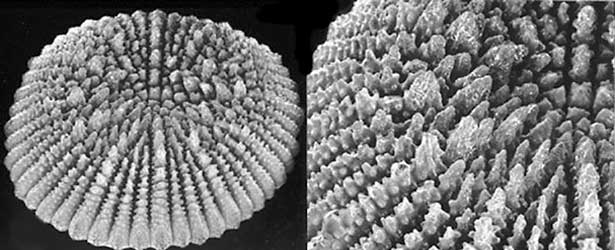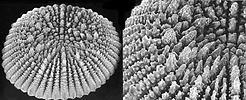Anthemiphylliidae
Anthemiphyllia
Stephen D. Cairns- Anthemiphyllia spinifera
- Anthemiphyllia multidentata
- Anthemiphyllia macrolobata
- Anthemiphyllia patera
- Anthemiphyllia dentata
- Anthemiphyllia pacifica
- Anthemiphyllia frustum
- Anthemiphyllia catinata

- Anthemiphyllia verbeeki

Introduction
Members of this family are known from the Late Eocene (about 45 million years ago, see Wells, 1977) to the Recent, and occur in the tropical and warm temperate Indo-West Pacific and tropical western Atlantic regions at depths of 50 to 700 m. Because they occur in relatively deep water they are exclusively azooxanthellate. Consequently, anthemiphylliids are relatively small, the largest known being a flat, disc-shaped corallum 21 mm in diameter. Seven Recent species are known (Cairns, 1999), as well as two fossil species.
Anthemiphylliids are exclusively solitary and usually discoidal to bowl-shaped in growth form, never forming colonies. One species, A. frustum, is known to reproduce asexually by transverse division. Although not the only faviine genus to be solitary, Anthemiphyllia is one of the few genera of the suborder Faviina to have this growth form (see Best and Hoeksema, 1987). Most anthemiphylliids live unattached to a substratum, but some species retain an attachment, especially in the young stages. One species, A. dentata, is the host for the galls of parasitic ascothoracidan Crustacea (Grygier, 1991).
Characteristics
Exclusively solitary, discoidal to bowl-shaped coralla; wall septothecate, usually costate. No epitheca or endotheca. Septa composed of a single fan system of simple trabeculae, but producing a coarsely dentate (laciniate) septal margin.
Discussion of Phylogenetic Relationships
No phylogenetic analysis has been performed on the species of Anthemiphyllia.
References
Best, M. B., and B. W. Hoeksema. 1987. New observations on scleractinian corals from Indonesia: 1. Free-living species belonging to the Faviina. Zoologische Mededelingen, 61(27): 387-403.
Cairns, S. D. 1979. The deep-water Scleractinia of the Caribbean Sea and adjacent waters. Studies on the Fauna of Curaçao and other Caribbean Islands, 57: 341 pp.
Cairns, S. D. 1994. Scleractinia of the temperate North Pacific. Smithsonian Contributions to Zoology, 557: 150 pp.
Cairns, S. D. 1999. Cnidaria Anthozoa: Deep-Water Azooxanthellate Scleractinia from Vanuatu, and Wallis and Futuna Islands. Mémoires du Muséum National d.Histoire Naturelle, 180: 31-167, including 22 plates, 2 figures.
Grygier, M. J. 1991. Additions to the ascothoracidan fauna of Australia and south-east Asia (Crustacea, Maxillopoda): Synagogidae (part), Lauridae and Petrarcidae. Records of the Australian Museum, 43: 1-46.
Romano, S. L. and S. D. Cairns. 2000. Molecular phylogenetic hypotheses for the evolution of scleractinian corals. Bull. Mar. Sci., 67(3): 1043-1068.
Vaughan, T. W. 1907. Recent Madreporaria of the Hawaiian Islands and Laysan. Bulletin of the United States National Museum, 59: 427 pp.
Wells, J. W. 1956. Scleractinia. Pp. F328-F444 In: Moore, R. C. (editor) Treatise on Invertebrate Paleontology, Part F: Coelenterata. University of Kansas Press, Lawrence.
Wells, J. W. 1977 (1976). Eocene corals from Eua, Tonga. Geological Survey Professional Paper, 640G: G1-G18.
Title Illustrations

| Scientific Name | Anthemiphyllia frustum |
|---|---|
| Location | Kyushu, Japan (depth 237 m) |
| Reference | Cairns, S. D. 1994. Scleractinia of the temperate North Pacific. Smithsonian Contributions to Zoology, 557: 150 pp. |
| Specimen Condition | Dead Specimen |
| Body Part | septal spines of a skeleton |
| View | Oblique calicular view and SEM detail |
| Size | Diameter of corallum 8.2 mm |
| Image Use |
 This media file is licensed under the Creative Commons Attribution-NonCommercial License - Version 3.0. This media file is licensed under the Creative Commons Attribution-NonCommercial License - Version 3.0.
|
| Copyright |
© 1994

|
About This Page
Creation of this page was supported by US National Science Foundation grants DEB95-21819 and DEB 99-78106 (in the program PEET - Partnerships to Enhance Expertise in Taxonomy) to Daphne G. Fautin, grant DEB99-78086 (in the program PEET) to Stephen D. Cairns, and grant OCE 00-03970 (in NOPP, the National Oceanographic Partnership Program) to D.G.F. and Robert W. Buddemeier.
Technical assistance was rendered by Adorian Ardelean.
The author welcomes the opportunity to identify specimens from this family, and offers to incorporate them into the collection of the National Museum of Natural History, Smithsonian, unless their return is requested.

Smithsonian Institution, Washington, D. C., USA
Correspondence regarding this page should be directed to Stephen D. Cairns at
Page copyright © 2002
 Page: Tree of Life
Anthemiphylliidae . Anthemiphyllia .
Authored by
Stephen D. Cairns.
The TEXT of this page is licensed under the
Creative Commons Attribution-NonCommercial License - Version 3.0. Note that images and other media
featured on this page are each governed by their own license, and they may or may not be available
for reuse. Click on an image or a media link to access the media data window, which provides the
relevant licensing information. For the general terms and conditions of ToL material reuse and
redistribution, please see the Tree of Life Copyright
Policies.
Page: Tree of Life
Anthemiphylliidae . Anthemiphyllia .
Authored by
Stephen D. Cairns.
The TEXT of this page is licensed under the
Creative Commons Attribution-NonCommercial License - Version 3.0. Note that images and other media
featured on this page are each governed by their own license, and they may or may not be available
for reuse. Click on an image or a media link to access the media data window, which provides the
relevant licensing information. For the general terms and conditions of ToL material reuse and
redistribution, please see the Tree of Life Copyright
Policies.
- First online 28 October 2002
Citing this page:
Cairns, Stephen D. 2002. Anthemiphylliidae . Anthemiphyllia . Version 28 October 2002. http://tolweb.org/Anthemiphyllia/19088/2002.10.28 in The Tree of Life Web Project, http://tolweb.org/









 Go to quick links
Go to quick search
Go to navigation for this section of the ToL site
Go to detailed links for the ToL site
Go to quick links
Go to quick search
Go to navigation for this section of the ToL site
Go to detailed links for the ToL site